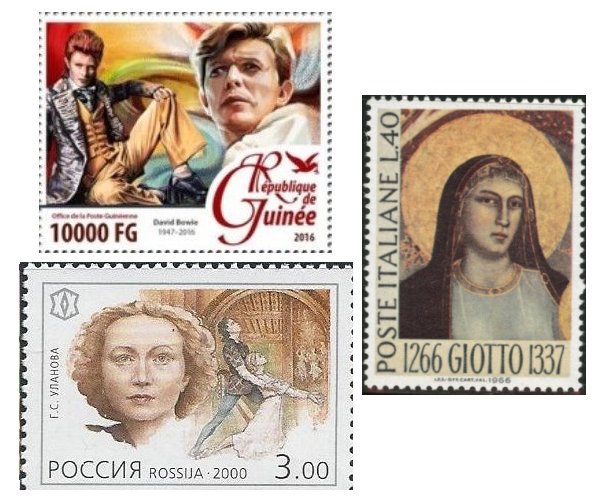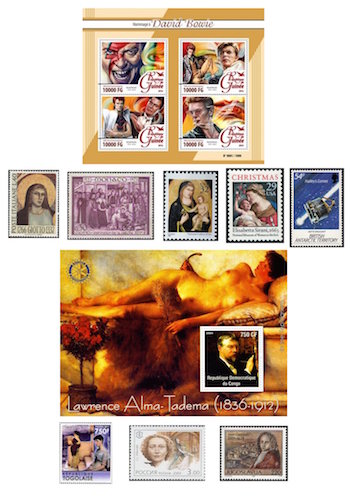The Arts on Stamps of the World — January 8
An Arts Fuse regular feature: the arts on stamps of the world.

By Doug Briscoe
Today we acknowledge the anniversaries of three (or four) painters, a Russian ballerina, a Croatian Baroque poet, and the late David Bowie.
David Bowie, born David Robert Jones on this date in 1947, changed his stage name partly to avoid confusion with Davy Jones of the Monkees. The enormously gifted Bowie, who also had a distinguished career as a film actor, was something of a musical (and sartoreal) chameleon with his various shifts of style over the years. His 1977 albums “Low” and “Heroes” were the inspiration for the First and Fourth Symphonies of Philip Glass. Bowie also painted (he is today’s above-referenced Painter #4) and was an ardent art collector. I can’t resist adding that I went to junior high school with a kid who grew up to become a hairdresser and, I am told, coiffed and became friends with Bowie and his first wife Angie. My schoolmate fell to his death from a fire escape in New York City at the age of 20, and I didn’t find out about it until forty years later. Bowie himself died almost exactly one year ago, on 10 January 2016. A word about the stamps: as a means of earning revenue, many countries issue what we philatelists call “souvenir sheets,” designed not so much for use as postage as for collectors. One such, the colorful sheet from The Republic of Guinea seen here, was issued after Bowie’s death. Others exist that came out during his lifetime.
Today is not the birthday, which is unknown, of our Painter #1, but rather the date on which he died. The great master Giotto di Bondone, born around 1266/7, died on 8 January 1337. Offered here are a few examples of stamps depicting his art, not necessarily to commemorate the artist himself. One of them was issued as a Christmas stamp by the United States for the 1995 season. I also throw in one of a considerable number of stamps celebrating the Giotto spacecraft and its 1986 rendezvous with Comet Halley. This one was issued under the auspices of the British Antarctic Territory.
Painter #2 is Elisabetta Sirani (8 January 1638 – 28 August 1665), who was also selected for a US Christmas stamp, as it happens, the year before the Giotto stamp (1994). Sirani’s father was a painter (he had studied with Guido Reni, whose influence can be seen in her work), and his daughter took over the running of the family workshop while still in her teens. Sirani’s native Bologna was receptive to women artists, and she trained not only her own younger sisters but a good dozen other young women besides her male students. Her tragic death at age 27, at first treated as a poisoning, is now arributed to peritonitis. She left us some 200 paintings and hundreds of drawings. In the year in which the Christmas stamp came out—it was the first US Christmas stamp to use art by a woman—Sirani was further honored when a crater on the planet Venus was named for her.

Sir Lawrence Alma-Tadema was born in the Netherlands as Lourens Alma Tadema in 1836. The only reason he was permitted to study art rather than the law was that he was sickly and not expected to live long. After study in Belgium, he settled in what became his permanent home, Britain, in 1870. His contact with the Pre-Raphaelites influenced his work, which focused on classical subjects, especially scenes of ancient Rome. He met with great popular and financial success and became keenly interested in theatre and costume design. Another product of cross-pollination in the arts was his portrait of a young Paderewski. Alma-Tadema died on 25 June 1912, and his work fell into disrepute for decades until its reexamination in the 1960s. Again we must turn to souvenir sheets, the one from Congo (DR) reproducing The Tepidarium (1881) and one stamp from a Togolese sheet combining details from Alma-Tadema’s Hero (1898) and Portrait of Miss Alice Lewis (1884).
Russian ballerina Galina Ulanova was born in Saint Petersburg on this date in 1910 (O.S. 26 December 1909). Her mother was a dancer with the Imperial Russian Ballet. Galina herself joined the Mariinsky Theatre in 1928 and was prima ballerina assoluta at the Bolshoi Theatre from 1944 to 1960, in which year she was elected a Foreign Honorary Member of the American Academy of Arts and Sciences. In 1945 she created the title role in the world première of Prokofiev’s Cinderella. Ulanova received many honors, including four Stalin Prizes. She died at age 88 on 21 March 1998.
Lastly, we turn to Ivan Gundulić (aka Gianfrancesco Gondola; 8 January 1589 – 8 December 1638), child of a wealthy Croatian noble house of Ragusa, who turned to the writing of poetry and plays and left three major works: an epic poem, Osman, which has come down to us incomplete, the 14th and 15th of its 20 cantos missing, a pastoral play, Dubravka (1628), and a religious poem, Tears of the Prodigal Son (1622). There is an opera by Boris Papandopulo (we’ll see his stamp on his birthday in February), based in part on Osman, entitled Sunčanica (1942). The Gundulić stamp was issued by Yugoslavia for his quatercentenary in 1989.
A graduate of the University of Massachusetts with a B.A. in English, Doug Briscoe worked in Boston classical music radio, at WCRB, WGBH, and WBUR, for about 25 years, beginning in 1977. He has the curious distinction of having succeeded Robert J. Lurtsema twice, first as host of WGBH’s weekday morning classical music program in 1993, then as host of the weekend program when Robert J.’s health failed in 2000. Doug also wrote liner notes for several of the late Gunther Schuller’s GM Recordings releases as well as program notes for the Boston Classical Orchestra. For the past few years he’s been posting a Facebook “blog” of classical music on stamps of the world, which has now been expanded to encompass all the arts for The Arts Fuse.
